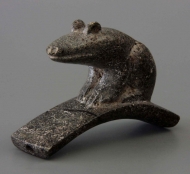Hopewell effigy pipe
December 2005

In the 1840s the Hopewell culture was discovered during excavations in the state of Ohio, where two large complexes of pipes were found that show specific characteristics. Typical are figurative representations in which the bowl of the pipe is hidden and that are placed on a kind of platform, usually with a slight bow or bend that functions as a short stem. The pipes are carved from a local type of stone that is more fragile than you would expect. The illustrated pipe with a bowl shaped as a sitting frog is a representative example of the Hopwell pipe. The silhouette of the pipe has the mystical appearance characteristic of this culture. In addition, the stylization of the frog with its convex eyes is very well done and shows great ability in abstraction. The Hopewell culture flourished between 200 BC and 500 in the forest area of eastern America. However unexpected the design of the pipes might be, members of the tribe themselves were worldly-minded, for they maintained contacts with many other ethnic tribes, almost from the east coast to the west coast of America. The Hopewell designation also refers to a way of life to be found in various local American Indian tribes. The most characteristic of this culture is the construction of earthen walls and mountains in specific forms. That is why these people are also called Moundbuilders.
Amsterdam Pipe Museum APM 17.639
Archive object of month